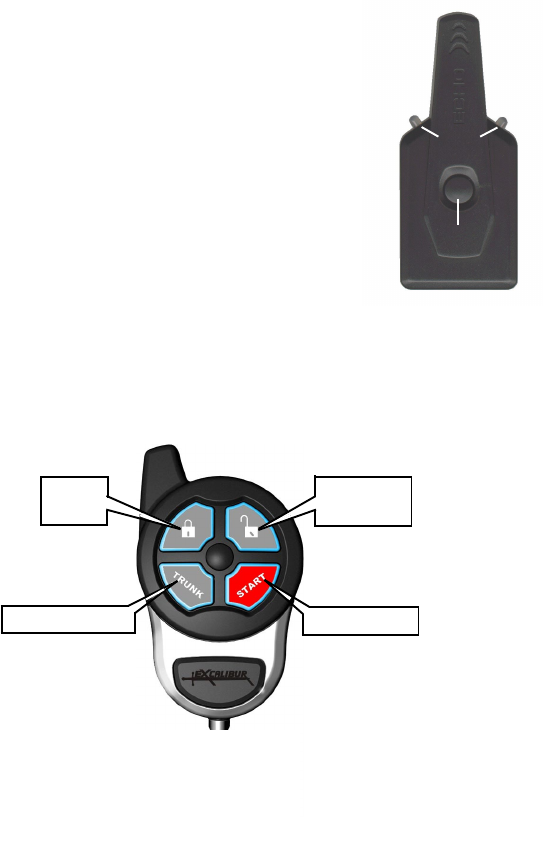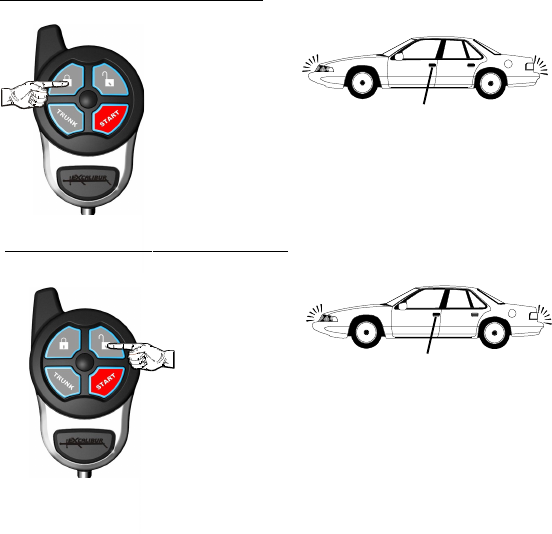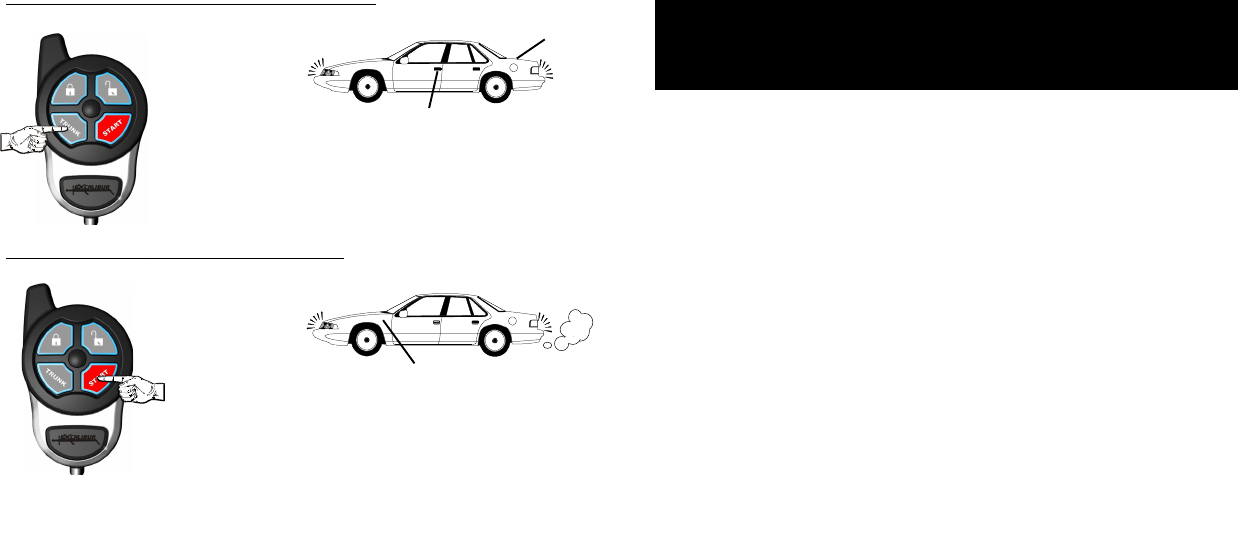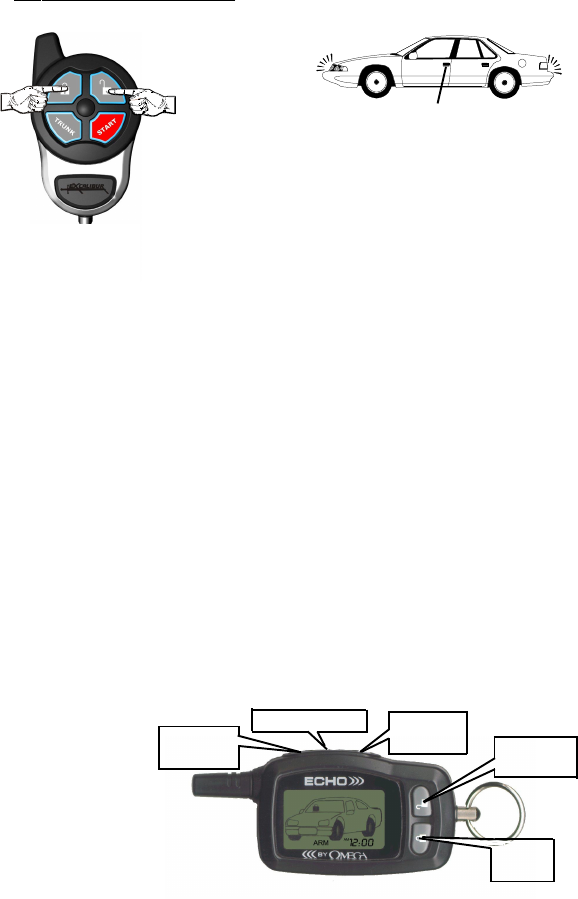Nutek 147 Security/Remote Control Transmitter User Manual MAX EDP Owner Paginated
Nutek Corporation Security/Remote Control Transmitter MAX EDP Owner Paginated
Nutek >
User Manual

COPYRIGHT 2007: OMEGA RESEARCH & DEVELOPMENT, INC.
Omega
RS-310-EDP
OPERATION MANUAL
Products manufactured and sold by OMEGA RESEARCH & DEVELOPMENT,
INC. (the "Company"), are warranted to be free from defects in materials and
workmanship under normal use. If a product sold by the Company proves to be
defective, the Company will repair or replace it free of charge within the first year
and thereafter all parts to be repaired will be free with only a nominal charge for
Omega's labor and return shipping, to the original owner during the lifetime of the
car in which it was originally installed.
All products for warranty repair must be sent postage prepaid to Omega
Research & Development, Inc., P.O. Box 508, Douglasville, Georgia 30133, or
send via UPS to: 981 N. Burnt Hickory Rd., Douglasville, Georgia 30134, with
bill of sale or other dated proof of purchase. This warranty is nontransferable and
does not apply to any product damaged by accident, physical or electrical misuse
or abuse, improper installation, alteration, any use contrary to its intended
function, unauthorized service, fire, flood, lightning, or other acts of God.
This warranty limits the Company's liability to the repair or replacement of
the product. The Company shall not be responsible for removal and/or reinstallation
charges, damage to or theft of the vehicle or its contents, or any incidental or
consequential damages caused by any failure or alleged failure of the product to
function properly. UNDER NO CIRCUMSTANCES SHOULD THIS
WARRANTY, OR THE PRODUCT COVERED BY IT, BE CONSTRUED
AS A GUARANTEE OR INSURANCE POLICY AGAINST LOSS. The
Company neither assumes nor authorizes any person or organization to make any
warranties or assume any liability in connection with the sale, installation, or use
of this product.
This device complies with F.C.C Rules part 15. Operation is subject to the
following two conditions: (1) This device may not cause harmful interference
and, (2) This device must accept any interference that may be received, including
interference that may cause undesired operation.
The manufacturer is not responsible for any radio TV interference caused by
unauthorized modifications to this equipment. Such modifications could void the
user’s authority to operate the equipment.
L I M I T E D L I F E T I M E W A R R A N T Y
Omega Research and Development, Inc.
P. O. Box 508
Douglasville, Georgia 30133
www.caralarm.com
07/08 MO-RS-310-EDP REV0

This device complies with FCC Rules part 15. Operation is subject to the
following two conditions, (1) This device may not cause harmful inter-
ference and, (2) This device must accept any interference that may be
received, including interference that may cause undesired operation.
The manufacturer is not responsible for any radio or TV interference
caused by unauthorized modifications to this equipment. Such modifica-
tions could void the user's authority to operate the equipment.
Omega Research and Development, Inc. www.caralarm.com
Page - 2
Coin batteries used in the transmitter which is used to operate this
security system may contain Perchlorate Material - special handling
may apply. See www.dtsc.ca.gov/hazardouswaste/perchlorate
Page - 19
Complete Programmable Features Matrix
USER Features Ignition on, off, then press Valet Switch 5 times (BLUE Status Light).
# Feature Lock Button Unlock Button Trunk Button Start Button
1 Remote Start Run Time 10 Min. 5 min. 15 min. 20 min.
2 Steady/Flash Lights Rem. Start Steady Flashing
3 Confirmation Chirps/Volume Low Loud On Demand/Loud OFF
4 Pulsed Horn / Steady Siren Pulsed Lo Pulsed Med. Pulsed Hi Steady Siren
5 Doors Lock With Ignition On ON OFF
6 Doors Unlock With Ignition Off ON OFF
INSTALLER Features Ignition on, off, then press Valet Switch 10 times (BLUE Status Light).
1 Remote Start Activation Pulses 1 2 3 4
2 “Tach Wire” or “Tachless “ Tachless Tach Data Tach
3 Gasoline or Diesel Engine Gasoline Diesel
4 Sat. Port Green Wire Function Starter Pulse After Start Pulse After Stop Accessory Output
5 Ext. Starter Cranking Time .7 (minimum) 1.25 1.75 2.5 (maximum)
6 Doorlock Functions .8 second 3 Seconds Double Unlock Total Closure
7 Turbo Timer OFF 1 min. 2 min. 3 min.
Table of Contents
Introduction/System Overview ................................................ 3-5
Valet Switch Overview ................................................................ 4
Transmitter Overview................................................................... 4-5
Using the RS-310-EDP System............................................... 5-9
Locking The Doors....................................................................... 5
Unlocking The Doors ................................................................... 5
Trunk Release/2nd Channel ......................................................... 6
Remote Starting ............................................................................ 6
Panic Mode ................................................................................... 7
Other Transmitter Functions ........................................................ 7
Using The Optional ECHO 2-Way Upgrade ............................... 7
Using The Valet Switch .......................................................... 8
Valet Mode ................................................................................... 8
Emergency Override ..................................................................... 8
Pit-Stop Feature............................................................................ 8
Other Remote Start Features ................................................... 9
Low Battery Automatic Starting .................................................. 9
Turbo Timer Feature .................................................................... 9
Status Light Functions ............................................................. 9-10
Transmitter Protection............................................................. 10
How to Program Transmitters ................................................. 11
How to Program Features........................................................ 12-13
User Programmable Features .................................................. 13-14
Installer Programmable Features............................................. 15-18
Complete Programmable Features Matrix .............................. 19
Limited Lifetime Warranty .............................................. Back Cover
- IMPORTANT -
The RS-310-EDP has many programmable features which can offer
more operations than those described in the basic system instruc-
tions. Mostly, these extra features and operations are configured
at the time of installation. Please read the sections of this manual
which explain programmable features, and consult your installer
for specifics on how your system is configured, and for installation
options which can be added to system after installation.
Page - 3Page - 18
Welcome to the convenience which is offered by your RS-310-EDP
keyless entry & remote start system. The RS-310-EDP is designed and
manufactured by Omega Research and Development, a world leader in
vehicle convenience and security since 1975. Your system offers easy,
carefree operation, and the modular design allows its many impressive
features to be customized to suit your needs. Omega systems are designed
for professional installation, and are available only through new car retail
outlets and selected mobile electronics specialist dealers.
Please note that this guide is written to reflect:
- That a power doorlock interface is installed with your system
(the RS-310-EDP also operates your power doorlocks). The type
of interface may vary from one vehicle to the other, and in some
cases may involve optional components.
- That the RS-310-EDP operating the vehicle's existing horn is
an available option.
- That the Programmable Features are in the default settings;
the operations of these features are also explained.
Your RS-310-EDP system has three principal user components: the
Blue LED Status Light, the Valet Switch, and the Remote Transmitter.
Introduction
The Valet Switch is used to access Valet Mode, which allows the
operator to suspend some of the security system's normal functions for as
long as desired. The Valet Switch may also be used, instead of the remote
transmitter, to override a locked system. The Valet Switch is also used when
programming remote transmitters and system features. See “Using the
Valet Switch” on page 8.
The Blue LED Status Lights informs you at a glance which of the
different conditions the system is in, and also serves as a visual deterrent
to break-ins and theft. Specific operations of this light are described on
pages 9-10.
Transmitters are used to operate the RS-310-EDP. Each system is
capable of being operated by up to four different remote Transmitters. The
remote transmitter has four push-button switches, each being labeled with
an icon as to function.
However, a popular upgrade option is the Echo 2-way controller. The
Echo, in addition to operating your system, also receives signals from the
system, and displays a variety of system conditions on its LCD screen. A
section of this booklet describes operating the RS-310-EDP with the Echo.
Feature #7 Turbo Timer
Factory Default Setting: Off (press “lock” button to program)
Options:
Run 1 Minute (press “unlock” button to program)
Run 2 Minutes (press “trunk” button to program)
Run 3 Minutes (press “start” button to program)
This feature when turned on configures the RS-310-EDP to automatically keep the
engine running briefly after it is turned off. This operation is designed specifically
for vehicles having turbocharged engines (the user may temporarily bypass the
feature if desired).
This feature should only be programmed by the installer, and the operation of
this feature depends on the correct connection of the safety wire to the vehicle’s
parking brake. Please refer to the “Black/White wire” in the installation manual for
the proper connection of this important wire.
• The second setting (programmed by the “unlock” button) changes the
lock and unlock outputs to be a longer 3 second pulse output. This is for certain
vehicles which require a longer output pulse from the system’s control unit;
typically cars having vacuum pump systems, although the longer setting is also
more suitable in some newer vehicles.
• Some newer vehicles require a double pulse output to remotely unlock the doors
and/or to disarm a factory-equipped security system, which is what the Double
Pulse Unlock setting provides (it is programmed by the “trunk” button ). The
lock output pulse, in this setting, is 0.8 second.
• The Total Closure Lock Output (programmed by the “start” button) may be
used with vehicles which are originally equipped with the total-closure feature.
Typically, a total closure feature is when locking the vehicle’s doors if the key
in the door is held to “lock” for a period of time the vehicle will close all
windows and the sunroof, in addition to locking the doors.
Selecting this feature setting changes the system’s door lock output pulse from
a 0.8 second to as long as a 28 second duration output. The unlock output is 0.8
seconds in this setting.
Note: When this feature is turned on, during the 28 second period after arm-
ing the system, the lock output can be stopped on demand by pressing the
“lock” or “unlock” button. Only the output will stop- pressing
either button again will normally operate the system, and at any time after the
28 second lock output period ends.

Page - 4 Page - 17
The Window Unit With Status Light & Valet Switch
Valet
Switch
Status
Light
• The Valet Switch is used in the procedure of programming operational
features and also for encoding transmitters to the system. A complete
description of the Valet Switch and its operations is on page 8.
The Blue Status Lights report the operational status
of the system at all times, and also serves as a visual
deterrent to break-ins and theft. Specific description
of the Status Light operation may be found on pages
9-10.
The Valet Switch has three main functions:
• The Valet Switch can be used to turn off the
remote engine starting functions of the system placing
it in “Remote Start Valet Mode”.
• The Valet Switch can also be used, in conjunction
with the vehicle’s ignition key, to perform an emergency
override when the system is in a “locked” state. This
is used in the event the transmitter is lost or becomes
inoperable. This is referred to as “performing an
Emergency Override”.
One of the components, typically mounted on the windshield, is the
Window Unit module which contains the Status Lights and the Valet
Switch. The window unit also receives communications from the system’s
remote transmitters.
The Transmitter & Basic Functions
“start” button
“trunk” button
“lock”
button “unlock”
button
Transmitter part numbers:
147-03 buttonsw/ text, chrome finish
147-03B buttons w/ icons, black chrome finish
Transmitter battery replacement:
Remove the small screw from the
lower back case, and separate the
transmitter case halves. Replace the
CR2032 (or 2 CR2016 batteries) coin-
type battery and reassemble the transmitter.
Feature #5 Extended Starter Cranking Time
Factory Default Setting: Minimum (.7 Second)
(press “lock” button to program)
Options:
Medium Lo (1.25 Second) (press “unlock” button to program)
Medium Hi (1.75 Second) (press “trunk” button to program)
Maximum (2.5 Second) (press “start” button to program)
Extended Starter Cranking Time operates in conjunction with the feature #2’s
“Tachless” setting. When the system is set for “Tachless”, this feature sets the
duration of the starter output for the 1st start attempt. If the engine doesn’t start on
the first attempt, the system will retry up to 3 more times. With each attempt, the
output will be extended by 0.2 seconds. There are four different base starter output
settings. While the default-set minimum is sufficient for most vehicles; the
Extended Starter Cranking Time can be used for difficult-to-start engines. This
feature should only be programmed by the installer.
This feature changes the operation of the Green wire (negative) on the satellite relay
port. This gives you the flexibility to accomodate certain vehicles that require any
out-of-the-ordinary pulses or remote start timing.
• The first setting operates as a secondary START output. This will have the same
pulse timing as the large Violet wire on the main harness.
• The second setting will give a 0.8 second pulse immediately after the large
Violet wire’s output stops.
• The third setting will give a 0.8 second pulse immediately after the remote start
shuts down by any means.
• The fourth setting operates as a secondary ACCESSORY output. This will have
the same operation as the large Orange wire on the main harness. This fea-
ture should only be programmed by the installer.
Feature #6 Doorlocking Functions
Factory Default Setting: 0.8 Second Lock & Unlock Output
(press “lock” button to program)
Options:
3 Second Lock & Unlock Output (press “unlock” button to program)
Double Pulse Unlock Output (press “trunk” button to program)
Total Closure Lock Output (press “start” button to program)
This single feature gives the installer several needed options, to match the RS-310-
EDP’s doorlocking outputs to suit different vehicle requirements.
• The first setting (programmed by the “lock” button) has the system
produce both the lock and unlock outputs as 0.8 second in duration. This is the
most common form of output needed, which interfaces most vehicles.

Page - 5Page - 16
“lock” button
• Pressing and releasing the “lock” button locks the doors.
• Pressing and holding this button for three seconds will first lock, then
activate the Panic feature.
“unlock” button
• Pressing and releasing the “unlock” button unlocks the doors
• Pressing and holding this button for three seconds will first unlock,
then activate the Panic feature.
”trunk” button
• Pressing the “trunk” button for two seconds will activate the “2nd
channel” output, for an optional function such as trunk release.
• Pressing and releasing this button twice, locks or unlocks the system
without confirmation chirps.
”start” button (red)
• Pressing & releasing the “start” button once will activate the remote start
feature. Pressing it again, during remote start, will stop the engine.
Using The RS-310-EDP System
THE PARKING
LIGHTS WILL FLASH
ONCE
THE DOORS WILL LOCK
To Lock the Vehicle's Doors:
Press & Release the transmitter LOCK button
•The parking lights flash once to confirm locking, and
optionally, the horn will chirp once. The Status Light
will flash approximately once per second to indicate
that the system is in a LOCKED state.
Feature #2 “Tach Wire” , “Tachless”, or “Data Tach”
Starter Operation
Factory Default Setting: Tachless (press “lock” button to program)
Options: Tach Wire (press “unlock” button to program)
Data Tach (press “trunk” button to program)
This feature selects the RS-310-EDP processor’s method of determining the status
of the engine running during remote start operation. As explained in feature 5’s
description, “Tachless” mode has an associated base starter output time duration.
However, if the voltage fluctuation is detectable, the processor adjusts the starter
output time accordingly. When this feature is set for “Tach Wire” operation, the
base starter output increases to a maximum of 3 seconds, but the processor adjusts
the actual starter engagement time accordingly. Connecting and use of the “Tach
Wire” is the most reliable form of engine running information input, and its use is
recommended. Important: Before this feature is programmed, please refer to the
“Violet/White wire” section of the installation manual for proper wiring connec-
tion, and the Tach Learning Procedure. The “Data Tach” setting operates just like
the “Tach Wire” setting except it takes its reading from the D2D data port. Use of
this setting is determined by whether or not this feature is provided by the Databus
Interface module. If so, the Violet/White wire is not needed nor is the Tach Learning
Procedure Required. This feature should only be programmed by the installer.
Feature #3 Gasoline Or Diesel Engine
Factory Default Setting: Gasoline (press “lock” button to program)
Option: Diesel (press “unlock” button to program)
This feature changes the system's timing of the ignition and starter output sequence
for remotely starting vehicles with gas or diesel engines. When set for gasoline, the
starter output will occur 3 seconds after the ignitions turn on. Also, when the system
is in “Tachless” mode, the engine running status will be determined 10 seconds after
cranking. When set for diesel, the starter output will occur 20 seconds after the
ignitions turn on to allow for glow plug warming. Also, when the system is running
in “Tachless” mode, the engine running status will be determined 40 seconds after
cranking. This allows the vehicle battery(s) to recharge properly and show normal
voltage levels due to the heavy drain diesel engines have on the electrical system
during cranking. This feature should only be programmed by the installer.
Feature #4 Satellite Relay Port Green Wire Function:
Factory Default Setting: Starter (press “lock” button to program)
Options:
Pulse After Engine Start (press “unlock” button to program)
Pulse After Engine Stop (press “trunk” button to program)
Accessory (press “start” button to program)
THE PARKING
LIGHTS WILL FLASH
TWICE THEN TURN
ON FOR 30 SECONDS
THE DOORS WILL UNLOCK
To Unlock the Vehicle's Doors:
Press & Release the transmitter UNLOCK button
• The parking lights flash twice then stay on for 30
seconds to confirm unlocking, and optionally the horn
will chirp twice. The Status Light will turn off to indi-
cate that the system is in an UNLOCKED state.

Page - 6 Page - 15
NOTE: The system has a horn/siren output though its connection is optional.
THE PARKING
LIGHTS WILL FLASH
TWICE THEN TURN
ON FOR 30 SECONDS
THE DOORS WILL LOCK
THE PARKING
LIGHTS WILL TURN
ON
THE ENGINE WILL CRANK
To Activate Trunk Release/2nd Channel:
Press & hold the transmitter “trunk” button for 2 seconds
To Activate/Deactivate Remote Start:
Press & Release the transmitter “start” button
•The parking lights flash twice then stay on for 30
seconds to confirm unlocking, and optionally the horn
will chirp twice. The Status Light will turn off to indi-
cate that the system is in an UNLOCKED state.
THE TRUNK WILL OPEN
•Within a few seconds the lights will turn off and the starter will engage.
•The engine will start, run, and the starter will be disengaged.
•The lights will turn back on and remain on while the system is control-
ling the engine. The status light will then continue to flash slowly.
•If the engine stalls, the system will make 3 more attempts to restart it.
•The parking lights will turn on and the
Status Light will flash fast to confirm the starting
process has begun.
•The sytem will then turn on the ignition circuit.
Feature #1 Remote Start Activation Pulses
Factory Default Setting:
1 pulse (press “lock” button to program)
Options:
2 pulses (press “unlock” button to program)
3 pulses (press “trunk” button to program)
4 pulses (press “start” button to program)
This feature allows you to choose the number of pulses required on the White/Blue
activation wire to activate the remote start feature. This allows you to activate the
remote start with external devices. For example, you can connect this wire to a
factory installed keyless entry system. You can repurpose the factory lock button so
that multiple presses will activate the remote start. With any of the optional settings,
each 2nd, 3rd, or 4th pulse must occur within a 5 second window of the previous
pulse. This feature should only be programmed by the installer.
The Installer Programmable Features
The second group of features, the Installer Programmable Features, are accessed as
the second level of features’ programming, which is pressing the Valet Switch 10
times instead of 5 times when entering Programming Mode (page 12). Caution:
These features have a critical affect upon the system’s operations, and in many
cases, also upon the system’s wiring connections. These features should
NEVER be changed, except by the installer or other qualified professional. This
booklet should be consulted for the proper wiring connections, as associated with
these programmable features.
The Excalibur RS-310-EDP’s 7 Installer Programmable Features:
1 Remote Start Activation Pulses (White/Blue input wire)
2 “Tachless”, “Tach Wire”, or “Data Tach” Starter Operations
3 Gasoline or Diesel Engine
4 Satellite Relay Port Green Wire Operations
5 Extended Starter Cranking Times
6 Doorlock Functions
7 Turbo Timer
Use the step-by-step instructions on page 12 to change any of the Installer
Programmable Features, along with the feature’s option choices and related
programming controller/transmitter button assignment found in the following
individual feature descriptions.
Installer Programmable Features should only be used by the original
or other qualified installer, AND individual Installer Features should
only be used, where applicable, with the correct wiring connections.
When you leave your vehicle, simply set the climate controls for what
you would like to have operating upon remote starting - the heater, de-
froster or air conditioning.
Upon entering the vehicle place the ignition key in the switch and turn it
to the "On" position, pressing the brake pedal will deactivate the remote
start operation. Do not turn the key to the "Start" position!
If you decide not to drive your car after remote starting, you can simply
press & release the “start” button again to deactivate the remote start.
Otherwise, the system will “time-out” and turn off automatically after 10
minutes. NOTE: If the horn honks when attempting to remote start, the
system is indicating that a safety circuit is violated. This could mean that
the hood is open, the gear selector is not in park, or that the brake pedal is
being pressed.

Page - 7Page - 14
THE PARKING
LIGHTS WILL FLASH
REPEATEDLY
THE DOORS WILL LOCK or
UNLOCK
To Activate Panic Mode:
Press & Hold the LOCK or UNLOCK button for 3 seconds
•The horn will sound, the parking lights will flash and
the doors will lock or unlock, depending on the trans-
mitter button used. To deactivate Panic, simply press
either the LOCK or UNLOCK button again.
OR
Feature #5 Doors Lock With Ignition On
Factory Default Setting: Off (press “unlock” button to program)
Option: On (press “lock” button to program)
This feature configures the system to automatically lock the vehicle’s doors every
time that the ignition switch is turned on. The following feature #6 controls the
automatic unlocking operations.
Feature #6 Doors Unlock With Ignition Off
Factory Default Setting: Off (press “unlock” button to program)
Option: On (press “lock” button to program)
Similar to the previous locking feature, except this feature controls the unlock
operation when the ignition is turned off.
Feature #3 Confirmation Chirp Function & Volume
Factory Default Setting: Low
(press “lock” button to program)
Options:
High (loudest) (press “unlock” button to program)
On Demand / High (press “trunk” button to program)
OFF (no chirps) (press “start” button to program)
This feature allows the choice of two different volume levels of the system’s con-
firmation chirps and the ability to turn OFF chirps or have them on demand. When
programming, the you can hear and choose the setting with the best chirp volume.
The “On Demand” setting allows you to lock and unlock the doors without chirps.
Pressing either function a 2nd time, will produce confirmation chirps.
Feature #4 Steady Siren or Pulsed Horn
Factory Default Setting: Pulsed Horn Low
(press “lock” button to program)
Options:
Pulsed Horn Medium (press “unlock” button to program)
Pulsed Horn High (press “trunk” button to program)
Steady Siren (press “start” button to program)
This feature changes only the audible output, in three different pulse timings, which
allow a degree of customizing of the horn’s sound during the alarm activation. The
Steady Siren setting is exactly that- a steady output which an optional electronic
siren would require.
Feature #2 Steady/Flashing Lights During Remote Start
Factory Default Setting: Steady (press “lock” button to program)
Option: Flashing (press “unlock” button to program)
This Feature configures the operation of the vehicle’s parking lights during the
remote start operation. The default setting turns on the parking lights during remote
start; the other setting flashes the parking lights on and off during remote start.
Auxiliary Functions 1-4:
The actual operation of these functions will vary from car to car. They
are designed to operate extra vehicle functions like automatic sliding doors
or motorized hatches. Aux 1-4 are only available on certain vehicles when
this system is integrated with the vehicle’s data network. Consult with your
installing dealer to find out if any of these functions are available for your
vehicle. If so, confirm each operation with the transmitter and write each
function in the blank space provided below for later reference.
-Auxiliary 1 Function (___________________): To activate this
function, press and release the “trunk” and “start” buttons simultaneously.
-Auxiliary 2 Function (___________________): To activate this
function, press and release the “lock” and “trunk” buttons simultaneously.
-Auxiliary 3 Function (___________________): To activate this
function, press and release the “unlock” and “start” buttons
simultaneously.
-Auxiliary 4 Function (___________________): To activate this
function, press and release the “unlock” and “trunk” buttons
simultaneously.
Other Transmitter Functions
Using The Optional ECHO 2-Way Upgrade
“start” button “P”rogram
button “unlock”
button
“lock”
button
“trunk”
button
Please refer to the
ECHO manual for
further explanation
of it’s capabilities.

Page - 8 Page - 13
Feature #1 Remote Start Run Time
Factory Default Setting 10 Minutes
(press “lock” button to program)
Options:
5 Minutes (press “unlock” button to program)
15 Minutes (press “trunk” button to program)
20 Minutes (press “start” button to program)
This feature sets the period of time that the engine will run after being remotely
started. If the engine is not stopped by controller/transmitter command or a safety
circuit violation, the engine will automatically stop upon the expiration of the
selected time period. Caution: The remote engine starting feature should
NEVER be used when the vehicle is parked in an enclosed structure or garage.
The User Programmable Features
- SEE PAGE 12 FOR PROGRAMMING INSTRUCTIONS -
Each of the Programmable Features is described in detail in the
following pages. The User Programmable Features are described as a
first group, and the Installer Programmable Features as a second group.
This group of User Programmable Features are all accessed as a group in the first
level of features’ programming. These features have a direct affect upon the
system’s operations, so the programming and operation of each are described.
The Excalibur RS-310-EDP’s 6 User Programmable Features:
1 Remote Start Run Time
2 Steady / Flashing Lights During Remote Start
3 Confirmation Chirps / Volume
4 Pulsed Horn / Steady Siren
5 Doors Lock With Ignition On
6 Doors Unlock With Ignition Off
Use the step-by-step instructions on page 12, and the complete features matrix
on page 19, to change any of the programmable features. Each feature, the option
choices and related programming controller/transmitter button assignment are
described in detail in the following pages.
Valet Mode
The system may be placed into a “valet mode” which prevents the
remote start feature from being activated. It also disables confirmation
chirps when locking or unlocking the doors. Valet Mode should always be
used when you do not wish for remote starting to be operated, such as
when you have your vehicle serviced.
The Valet Switch, is used to engage Valet Mode:
•With the system in an unlocked state, press and hold the Valet Switch
for 3 seconds; the Status Light will light steady, to indicate Valet Mode, and
stay illuminated continuously while the system is in Valet Mode. The horn
will chirp once and the lights will flash twice.
Once in Valet Mode, an attempt to remote start will result in no response
from the system. Keep this in mind if remote start stops functioning. The
system may have accidentally been placed in valet mode. To check for
valet mode, turn the ignition key to the RUN/ON position, then back OFF.
If the system is in valet mode, the horn will chirp once.
•To turn off Valet Mode, simply press & release the Valet Switch once.
The Status Light will turn off.
Using The Valet Switch
Emergency Override
If the system is in a locked state, you cannot perform some functions
like transmitter or feature programming. If the system is locked and you do
not have a transmitter to unlock the system, you can perform an emer-
gency override to access the programming functions.
•With the system in a locked state, simply turn the ignition key to the
RUN/ON position.
•Press and release the valet switch once.
You should now be able to access programming functions.
Pit-Stop Feature
This feature allows you to leave your vehicle and keep the engine run-
ning for quick errands. To use this feature, have the engine running nor-
mally from the ignition switch, have the gear selector in “park”, and your
foot off of the brake pedal. Press the Valet Switch twice; the parking lights
will flash once and the horn chirps 5 times; then turn the ignition off. The
engine will remain running for the programmed run time, or it will turn off if
another transmitter signal is received, a safety circuit is violated, or if the
Valet Switch is pressed.
Step 7 Allow 10 seconds to pass without performing any programming
actions, or turn the vehicle’s ignition on.
• The horn will sound briefly (and the Status Indicator Light will go out).

Page - 9Page - 12
Turbo Timer Feature
It is typically recommended that vehicles equipped with turbocharged
engines allow the engine to idle for a few minutes before turning it off.
When this Installer Programmable Feature is programmed on, the RS-
310-EDP will automatically keep the engine running as follows:
Low Battery Automatic Starting Feature
Setting this feature to operate has the RS-310-EDP automatically start
the engine should the vehicle battery voltage drop to 10.5 volts. This fea-
ture is very useful if the vehicle is to parked unattended for a long period of
time, such as extended parking at the airport while away. Low Battery
automatic starting must be activated for each occasion in which you desire
it to operate, as follows:
• Turn the ignition switch “on”, then “off” (engine not running), and within
7 seconds press the brake pedal twice. The system will chirp 6 times.
Then, within 5 seconds, exit the vehicle and press the transmitter’s
“lock” button to lock the vehicle.
The feature is now turned on, and until the system is disarmed or the igni-
tion turned “on”, if the system detects the vehicle battery voltage dropping
to 10.5 volts, it will automatically start the engine.
Other Remote Start Features
To Access and Change further Features:
Step 6 If there are more features to be programmed, within 10 seconds of
the previous action Press & Release the Valet Switch the same
number of times as the next desired feature’s number.
• Again the horn will chirp, the parking lights, (and the Status Indicator Light)
will flash as many times as the Valet Switch was pressed to indicate the new
feature number which is now accessed. Then use the controller or transmitter
as described in Step 5 to change the newly accessed feature as desired.
Programming Features
•The horn will chirp then sound briefly (and the Status Light will turn on) to
confirm that the system is entering Programing Mode.
•In the case of accessing the Installer Mode, the horn chirps then briefly sounds
at the fifth valet switch press, and then again at the tenth valet switch press.
•In either Programming Mode, if 10 seconds of no programming activity
occurs, the system will exit Programming Mode.
5 times for User Programming
OR
10 times for Installer Programming
Step 3 Within 5 seconds, Press & Release the Valet Switchch either:
Step 2 Turn the ignition off.
Step 1 Turn the vehicles’s ignition on.
Access a Feature:
Step 4 Within 10 seconds, Press & Release the Valet Switch the same num-
ber of times as the desired feature’s number.
•The horn will chirp, the parking light output will flash, (and the Status
Indicator Light will flash) as many times as the Valet Switch was pressed to
indicate the feature number accessed.
Change the Feature:
Step 5 After accessing the desired feature, within 10 seconds Press &
Release the appropriate controller or transmitter button.
• Pressing the “lock” button typically turns the feature on; or sets the
feature’s first option. The horn will chirp once and the parking lights will
flash once when this button is pressed.
• Pressing the “unlock” button also typically turns the feature off; or,
sets the feature’s second option. The horn will chirp twice and the lights will
flash twice.
• Many features have third, and even fourth setting options. Pressing the “trunk”
and “start” buttons select these options. Confirmation chirps when these
buttons are pressed are three and four chirps respectively.
• With the engine running, hold the brake pedal and engage the parking
brake. When the brake pedal is released, the RS-310-EDP will keep the
engine running for the selected time, and then automatically turn it off.
The turbo timer feature must be programmed by the installer, and turn-
ing it on offers three run time choices- 1, 2, or 3 minutes. The system may
be locked while the engine is running. Turbo Timer can be prevented from
engaging, or “bypassed” if desired, by turning the engine off first and then
engaging the parking brake, or if it’s already engaged simply step on the
brake pedal to turn the running engine off.
The Status Light
The Status Light helps to visually confirms the status of the system and
provides a high level of visual deterrence. The Status Light is located in the
window mount receiver unit.
Normal System Status
2) On Constant = The system is in the Valet Mode, with the remote starter
system disabled.
1) Off = The system is unlocked and the remote starter system is off, but
in standby mode.

Page - 10 Page - 11
5) Flashing Slow (after sending the remote start command) = The engine
is running via the remote starting system.
Starting System Status
The Status Light also indicates the remote start status:
4) Off = The remote starter system is off and in standby mode.
6) Flashing Fast (after starting the remote start sequence) = A remote start
command has been received, and the system is in the process of
starting the engine.
Remote Starting Diagnostics
Whenever the system is placed into Valet Mode, the Status Light
illuminates solid. However, when this first occurs, the Status Light will flash
1 to 6 Green flashes before resuming solid illumination. This indicates why
the engine stopped running from the last previous remote starting attempt.
7) 1 Flash = Programmed run time expired.
8) 2 Flashes = Brake was pressed or hood opened.
9) 3 Flashes = Engine stalled or bad tach signal.
10) 4 Flashes = Received transmitter command to stop.
11) 5 Flashes = Gear selector removed from “park”.
12) 6 FLashes = Low voltage.
3) Flashing Slow = The system is locked, programming functions are
disabled and the remote starter system off and in standby mode.
Unauthorized Transmitter AlertTM (UTA) is a protection feature which
may be turned on by the user for added security (see “How to Program
Transmitters”). When this feature is utilized, a warning consisting of a brief
series of horn chirps sounds every time the vehicle’s ignition is turned on.
The warning will operate for 48 hours. ATV also extends to 90 seconds.
Automatic Transmitter VerificationTM (ATV) shows the total number of
transmitters which can operate the system, by flashing the Status Light with
this number for 10 seconds every time that the ignition key is turned on.
The Omega RS-310-EDP features several security safeguards in one
of the most vulnerable areas of any remotely controlled system.
Transmitter Protection
Code JumpingTM It is quite easy, with the proper equipment, to record an
alarm or keyless entry system’s transmitter signal, and simply play the
captured signal back to the system to defeat it. The RS-310-EDP’s Code
Jumping renders such “code grabbing” devices useless by randomly
changing each signal that the transmitter sends.
Step 1 Have all transmitters which are to operate the system at hand.
Then, turn the ignition “on”.
If the Unauthorized Transmitter Alert feature is on, programming a
transmitter to the system will activate the “UTA” warning and the
extended Status Light indication. For the next 48 hours, the horn will
sound a brief series of chirps every time the vehicle’s ignition key
is turned on.
Step 3 Press the “lock” button on each remaining transmitter one at a time.
The system will chirp the horn once to confirm that each was
learned. The transmitter’s other three button's functions will
automatically be assigned when the “lock” button is learned. If a
code is not received within a 10 second period, the learning process
will automatically terminate, as indicated by another horn honk.
Step 2 Within 5 seconds of turning on the ignition, press the Valet Switch
5 times. The horn will briefly sound, confirming that for the next 10
seconds the system is ready to learn a transmitter/controller code.
To enter a code, simply press and release the “lock” button. When
the first code is learned all existing stored codes will be erased.
Special Programming procedure to turn On the UTA feature: Using this
method to program transmitters or optional controllers, and to turn on or turn
off the Unauthorized Transmitter Alert feature.
Follow the same steps as the Standard Programming, but on any
transmitter/controller being programmed instead of pressing the “lock”
button, press the “lock” and the “unlock” buttons together. This action
turns on the Unauthorized Transmitter Alert feature and at the same time
programs the transmitter or controller to operate the system.
Standard Programming: Using this method to program additional or
replacement transmitters does not turn on or otherwise affect the
Unauthorized Transmitter Alert (UTA) feature.
The RS-310-EDP system is capable of being operated by as many as
four transmitters. Additional transmitters must be programmed to the
system in order to operate it (the originals, were programmed at the factory).
It is during the programming procedure that the Unauthorized Transmitter
Alert feature may be turned on.
How to Program Transmitters
Once the Unauthorized Transmitter Alert feature is turned on, the
warning will sound for 48 hours after any transmitter programming, including
the programming session which was used to turn it on. This feature can only
be turned off again by sending the system back to Omega for a reset.
Page - 20 Page - 21
Note: This equipment has been tested and found to comply with the limits
for a Class B digital device, pursuant to part 15 of the FCC Rules. These
limits are designed to provide reasonable protection against harmful
interference in a residential installation. This equipment generates,
uses and can radiate radio frequency energy and, if not installed and
used in accordance with the instructions, may cause harmful
interference to radio communications. However, there is no guarantee
that interference will not occur in a particular installation.
If this equipment does cause harmful interference to radio or television
reception, which can be determined by turning the equipment off and on,
the user is encouraged to try to correct the interference by one or
more of the following measures:
—Reorient or relocate the receiving antenna.
—Increase the separation between the equipment and receiver.
—Connect the equipment into an outlet on a circuit different from that
to which the receiver is connected.
—Consult the dealer or an experienced radio/TV technician for help.
Information to user
The users manual or instruction manual for an intentional or unintentional
radiator shall caution the user that changes or modifications not expressly
approved by the party responsible for compliance could void the user's
authority to operate the equipment. In cases where the manual is provided
only in a form other than paper, such as on a computer disk or over
the Internet, the information required by this section may be included in the
manual in that alternative form, provided the user can reasonably be
expected to have the capability to access information in that form.